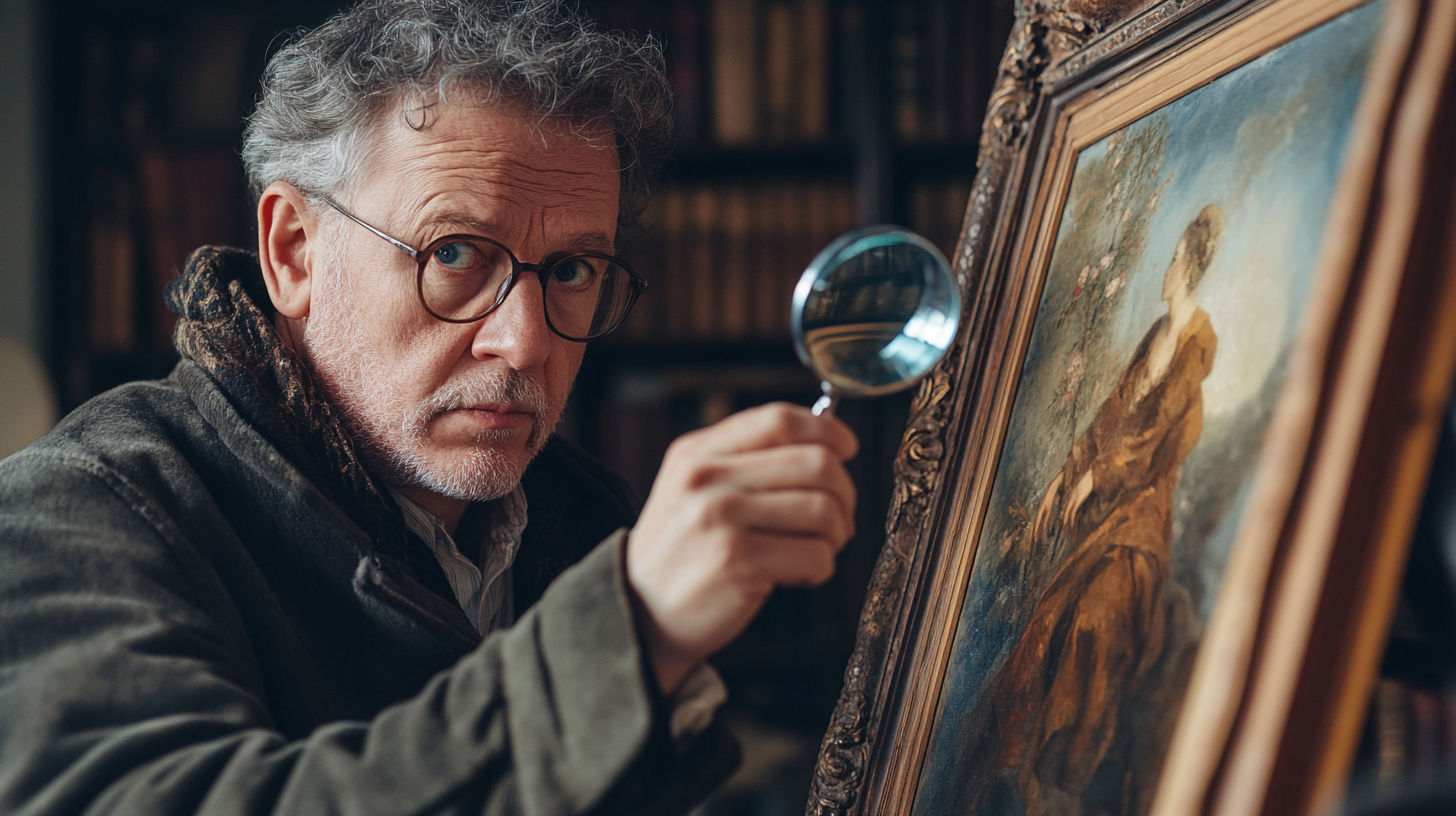Introduction to Art Appraisals
Art appraisals are an essential service for collectors, investors, institutions, and individuals who own artwork. Whether you need to establish the value of a painting for insurance purposes, tax considerations, estate planning, or a potential sale, a professional art appraisal provides an objective assessment based on expertise and market knowledge.
What is an Art Appraisal?
Art appraisals differ from casual opinions or online estimations. A proper appraisal follows specific industry standards, including the Uniform Standards of Professional Appraisal Practice (USPAP), and provides documented evidence to support the valuation. This thorough approach ensures that the appraisal can stand up to scrutiny from insurance companies, tax authorities, legal entities, and potential buyers.
Art Appraisal Market
Types of Art Appraisals
Art appraisals serve different purposes, and the approach and final valuation can vary significantly depending on the intended use. Understanding these differences is crucial when seeking appraisal services.
Insurance Appraisals
Insurance appraisals determine the replacement value of artwork - the cost to replace the item with one of similar quality and characteristics in the current retail market. These appraisals typically provide higher values than fair market appraisals, as they account for retail markups and the potential difficulty of finding exact replacements for unique pieces.
Fair Market Value Appraisals
Fair market value (FMV) appraisals estimate what a willing buyer would pay a willing seller when neither is under pressure to complete the transaction. These are commonly used for:
- Tax purposes (donations, estate taxes)
- Estate planning and division
- Divorce settlements
- Bankruptcy proceedings
The IRS has specific requirements for fair market value appraisals used for tax deductions and estate tax calculations, including appraiser qualifications and reporting standards.
Liquidation Value Appraisals
These appraisals determine the likely price if the artwork needs to be sold quickly, often resulting in lower valuations than fair market or replacement values. Liquidation appraisals may be needed for bankruptcy proceedings, estate liquidations, or forced sales.
Retail Replacement Value Appraisals
This type estimates what it would cost to purchase an equivalent piece from a retail gallery or dealer. It’s particularly useful for insurance purposes when the exact piece cannot be replaced.
Evolution of Art Appraisal Standards
- 1966
AAA Founded
Appraisers Association of America established to promote professional excellence in art appraisal field. - 1987
USPAP Created
Uniform Standards of Professional Appraisal Practice developed as authoritative guide for appraisal professionals. - 2006
Pension Protection Act
New regulations established stricter requirements for appraisals used for tax purposes, including appraiser qualifications. - 2019
Digital Transformation
Online art appraisal services become more prevalent, making valuations more accessible.
The Art Appraisal Process
Initial Consultation
The appraisal process typically begins with an initial consultation where you discuss your needs with the appraiser. During this phase:
- You’ll explain your reason for seeking an appraisal
- The appraiser will outline their process and fees
- You’ll schedule the actual appraisal examination
- The appraiser may request preliminary information about your artwork
Examination and Documentation
During the examination phase, the appraiser will:
- Physically inspect the artwork, examining size, medium, technique, and condition
- Document any damage, repairs, or alterations
- Photograph the artwork from multiple angles
- Note signature, dates, inscriptions, and any labels or stamps on verso
- Review any documentation of provenance you can provide
- Ask questions about the artwork’s history and acquisition
Art Appraisal Examination Checklist
Key elements examined during a professional art appraisal
- Artist identification and signature verification
- Medium and materials assessment
- Physical measurements
- Condition analysis and documentation
- Provenance verification
- Stylistic and period authentication
- Technical examination (may include UV light, magnification)
- Frame condition assessment (if applicable)
Research and Analysis
After examining the artwork, the appraiser conducts extensive research, which may include:
- Analyzing comparable sales from auction records and private sales
- Researching the artist’s market performance and sales history
- Consulting reference books, catalogs raisonnés, and other publications
- Contacting galleries, dealers, or other experts for additional insights
- Evaluating current market conditions and trends
- Reviewing exhibition history and literature references
Report Preparation
The final step is preparing the written appraisal report. A comprehensive art appraisal report typically includes:
- A detailed description of the artwork
- High-quality photographs
- The valuation and effective date
- The purpose of the appraisal
- The valuation approach and methodology
- Market data and comparable sales analysis
- Provenance information
- The appraiser’s qualifications and credentials
- A signed certification statement
- Any limiting conditions or assumptions
Factors That Determine Art Value
Artist Recognition and Reputation
The artist’s identity and standing in the art world significantly impact valuation. Works by established, recognized artists typically command higher prices than those by unknown or emerging artists. Factors include:
- Historical significance and influence
- Representation in major museum collections
- Critical reception and scholarly attention
- Market presence and exhibition history
- Career stage when the work was created
Provenance
Provenance - the documented history of an artwork’s ownership - can dramatically affect value. Desirable provenance includes:
- Clear chain of ownership from artist to present
- Previous ownership by notable collectors or institutions
- Exhibition history at prestigious venues
- Inclusion in important collections
- Documentation authenticating the work
Condition

The physical condition of artwork is crucial to its valuation. Appraisers carefully assess:
- Structural integrity
- Conservation history and quality of any restorations
- Surface damage, discoloration, or fading
- Environmental damage (water, smoke, light exposure)
- For contemporary art, whether the piece remains as the artist intended
Works in excellent, original condition generally receive higher valuations than damaged or heavily restored pieces.
Rarity and Scarcity
Rarity can significantly enhance value, particularly when an artist:
- Produced a limited body of work
- Created few works in a particular style or medium
- Has works primarily held in permanent museum collections
- Created the piece during a particularly significant or brief period
Medium and Materials
The medium and materials used affect both value and longevity. Considerations include:
- Traditional hierarchy of media (paintings often valued above works on paper)
- Quality and permanence of materials
- For contemporary art, innovative use of materials
- Size and scale of the work
- Technical complexity and execution
Market Trends and Demand
Current market conditions and collector interest play crucial roles in valuation:
- Recent auction results for similar works
- Gallery asking prices and private sale data
- Collector demand for the artist or genre
- Market trends and collecting patterns
- Economic conditions affecting the art market
Art Appraisal Services: Cost Ranges
Average pricing for professional art appraisal services (2023)
</tbody>
</table>
Finding a Qualified Art Appraiser
Professional Credentials to Look For
When seeking an art appraiser, verify their credentials and professional affiliations. Reputable appraisers typically belong to one or more of these professional organizations:
- Appraisers Association of America (AAA) - Members specialize in fine art, decorative arts, and antiques
- American Society of Appraisers (ASA) - Offers accreditation in multiple specialties including fine art
- International Society of Appraisers (ISA) - Provides certification for various appraisal specialties
Additionally, for tax-related appraisals, the IRS requires that appraisers meet specific qualifications outlined in their guidelines. These include education, experience, and professional recognition requirements.
Specialization Matters
Art is a vast field with numerous specialties. When possible, choose an appraiser who specializes in the type of artwork you own:
- Contemporary art
- Old Masters
- Regional or ethnic art
- Specific media (sculptures, prints, photographs)
- Particular periods or movements
A specialist will have deeper knowledge of the relevant market, authentication issues, and valuation challenges specific to your artwork.
Questions to Ask Potential Appraisers

Before hiring an appraiser, conduct an interview to assess their qualifications and fit for your needs:
- What are your credentials and professional affiliations?
- How long have you been practicing as an appraiser?
- Do you specialize in the type of artwork I own?
- Are you USPAP compliant and when did you last complete the required coursework?
- What is your fee structure and what does it include?
- How long will the appraisal process take?
- What information and documentation will you need from me?
- Will you provide a written report that meets insurance/IRS/legal requirements?
- Do you have any conflicts of interest related to this appraisal?
- Can you provide references from previous clients?
Red Flags to Watch For
Be wary of potential appraisers who:
- Offer to purchase the items they’re appraising (conflict of interest)
- Base their fee on a percentage of the appraised value
- Lack proper credentials or professional affiliations
- Cannot provide references or sample reports
- Promise unrealistically high valuations
- Rush through the examination process
- Are unwilling to explain their methodology
When to Get Your Art Appraised
Insurance Coverage
One of the most common reasons for art appraisals is obtaining appropriate insurance coverage. Consider getting appraisals:
- When acquiring valuable new artwork
- Every 3-5 years for works in active markets
- After significant market changes affecting similar works
- Following conservation or restoration work
- When changing insurance providers
Insurance companies typically require recent professional appraisals for high-value items to ensure adequate coverage in case of damage, theft, or loss.
Tax Considerations
Art appraisals are essential for various tax situations:
- Charitable Donations: The IRS requires qualified appraisals for art donations valued over $5,000
- Estate Planning: Establishing values for estate tax purposes
- Gift Taxes: Determining values when transferring ownership
- Inheritance: Establishing stepped-up basis for future capital gains calculations
For tax-related appraisals, ensure your appraiser meets all IRS requirements and can provide a report that complies with relevant regulations.
Sales and Purchases
Appraisals provide valuable guidance when buying or selling artwork:
- Before selling, to establish realistic asking prices
- When considering purchase offers
- Before consigning to galleries or auction houses
- When negotiating with potential buyers
- For insurance during transit or exhibition
Other Important Occasions
Other situations that may warrant art appraisals include:
- Divorce proceedings for equitable distribution
- Creating or updating estate plans
- Loan collateralization
- Corporate inventory and asset management
- Insurance claim situations
- Museum donations and bequests
Recent Notable Art Auction Results
High-profile art sales demonstrating market values
| Category | Price | Notes |
|---|---|---|
| Single Item Appraisal | $250 - $750 | For individual pieces based on complexity |
| Hourly Rate | $125 - $350 | Standard professional appraiser fee |
| Collection Appraisal | $1,500 - $10,000+ | Depending on size and complexity of collection |
| Online Appraisal | $36 - $150 | Digital services with faster turnaround |
| Insurance Appraisal Update | $150 - $400 | For updating existing appraisals |
</tbody>
</table>
Online vs. In-Person Art Appraisals
In-Person Appraisals: The Traditional Approach
In-person appraisals remain the gold standard, particularly for high-value items or complex appraisal needs. Benefits include:
- Direct physical examination of the artwork
- Ability to assess condition, materials, and technique first-hand
- Opportunity for detailed discussion with the appraiser
- More thorough documentation and photography
- Better suited for insurance, tax, and legal purposes
However, in-person appraisals typically:
- Cost more than online alternatives
- Require scheduling and logistical arrangements
- May have longer turnaround times
- Could be limited by geographic availability of specialists
Online Art Appraisals: Modern Convenience
Online appraisal services have gained popularity, offering:
- Lower costs (often starting at $36-$150)
- Quick turnaround times (as fast as 72 hours)
- Convenience and accessibility
- Options for preliminary valuations
Services like MutualArt offer online art valuations performed by experts with decades of experience, providing a convenient alternative for certain situations.
Choosing the Right Approach
Consider these factors when deciding between online and in-person appraisals:
- Value of artwork: Higher-value pieces generally warrant in-person assessment
- Purpose of appraisal: Tax and legal purposes may require in-person appraisals
- Urgency: Online services typically offer faster turnaround
- Budget constraints: Online services are usually more affordable
- Complexity: Unusual or rare items benefit from direct examination
- Authentication concerns: If attribution is uncertain, in-person is preferable
For preliminary estimates or lower-value items, online appraisals may be sufficient. For important pieces or formal valuation needs, traditional in-person appraisals remain the recommended choice.
External Art Appraisal Resources
Heritage Auctions Free Appraisals
Upload photos of your fine art or antiques for free evaluation by Heritage Auctions experts, who can provide estimated values and auction potential.
MutualArt Online Appraisal Service
Professional fine art valuation service with 72-hour turnaround, starting at $36, conducted by experts with over 30 years of experience.
Roth Art Group Appraisal Services
Full-service appraisal and collection management firm with qualified appraisers of fine art, antiques, and decorative arts.
Appraisal Requirements
IRS Art Appraisal Services guidelines for valuation of artwork for tax purposes, providing official requirements for compliant appraisals.
Art Appraisal Best Practices
Comprehensive guide from Risk Strategies debunking common appraisal myths and providing practical advice for obtaining reliable art collection appraisals.
The Fine Arts Conservancy Appraisal Guide
Professional guidance on art appraisals from a conservation perspective, emphasizing the importance of qualified appraisers for accurate valuations.
Selz Fine Art Appraisals
Professional appraisal service providing comprehensive IRS and USPAP compliant reports for single works or entire collections.
Preparing for Your Art Appraisal
Documentation to Gather
Compile as much documentation about your artwork as possible:
- Provenance records: Previous bills of sale, gallery receipts, inheritance documents
- Exhibition history: Catalogs, brochures, or listings showing where the work has been displayed
- Literature references: Books, articles, or catalogs where the work is mentioned or pictured
- Authentication documents: Certificates of authenticity, expert opinions, or artist confirmations
- Previous appraisals: Any earlier valuations of the artwork
- Conservation records: Reports of restoration or conservation treatments
- Import/export documents: For international acquisitions
- Artist information: Biographical details, especially for lesser-known artists
Photographic Documentation
For both in-person and online appraisals, quality photographs are valuable:
- Overall front view in good, even lighting
- Back of the artwork showing any labels, stamps, or inscriptions
- Close-ups of the artist’s signature
- Details of any damage or condition issues
- Photos of framing, if relevant
- Images showing scale (with a ruler or common object)
For online appraisals, these photos are essential and should be clear, well-lit, and high-resolution.
Artwork Condition
Before an in-person appraisal:
- Ensure the artwork is accessible and well-lit
- Remove from walls or storage if necessary
- Do not clean or repair the artwork beforehand
- Keep the piece in its normal environment
- Have tools available to remove from frames if needed (though let the appraiser decide if this is necessary)
Questions to Consider
Prepare answers to questions the appraiser may ask:
- How and when did you acquire the piece?
- What do you know about its history?
- Has it been restored or conserved?
- Has it been previously appraised?
- What is your purpose for the appraisal?
- Do you have any specific concerns about the artwork?
Common Questions About Art Appraisals
How much does an art appraisal cost?
Art appraisal costs vary widely based on the appraiser's qualifications, the type of appraisal needed, and the complexity of the artwork. Most professional appraisers charge between $125-$350 per hour for USPAP-compliant appraisals. A typical appraiser can assess 5-10 artworks per hour, depending on complexity.Online appraisals tend to be less expensive, with services starting from $36 for basic valuations. For comprehensive collection appraisals, expect to pay $1,500-$10,000 or more depending on collection size and complexity.
Be wary of appraisers who base their fees on a percentage of the appraised value, as this creates a conflict of interest and violates professional ethics standards.
How do I find out what my artwork is worth?
Determining the value of your artwork involves several options:
Professional appraisal: The most reliable method is hiring a qualified art appraiser who specializes in your type of artwork. They will provide a written, defensible valuation.
Auction house specialists: Major auction houses like Christie’s, Sotheby’s, and Heritage Auctions offer free evaluation services, especially if they believe your item might be suitable for auction.
Online appraisal services: Platforms like MutualArt offer more affordable online valuations by professional appraisers.
Comparable sales research: You can research recent auction results for similar works by the same artist through databases like Artnet, Artprice, or auction house archives.
Gallery consultations: Art galleries specializing in similar works might provide informal opinions on value, especially if you’re considering selling.
For valuable artwork or official purposes (insurance, taxes, estate planning), always choose a qualified professional appraiser.
Are art appraisals worth it?
Art appraisals are generally worth the investment in several situations:
Insurance purposes: Proper coverage requires accurate valuations, potentially saving you thousands in case of damage or loss
Tax situations: For donations, estates, or gifting, professional appraisals can substantiate claimed values and prevent costly disputes with tax authorities
Estate planning: Ensuring fair distribution and proper tax treatment of artwork
Selling decisions: Knowing the current market value helps you set realistic asking prices and avoid undervaluing your artwork
Learning opportunity: Appraisals often provide valuable information about your artwork’s history, significance, and authentication
While appraisals involve an upfront cost, they typically provide value far exceeding their expense in these situations. For casual inquiries or lower-value items, less formal valuation methods might be more cost-effective.
What is the best way to get art appraised?
The best approach to getting art appraised depends on your specific needs:
For insurance, tax, or legal purposes: Hire a qualified appraiser who is:
- Certified by a professional organization (AAA, ASA, or ISA)
- USPAP compliant
- Experienced with your type of artwork
- Independent (no conflicts of interest)
For potential sale: Consider:
- Auction house specialists if the work might be auction-worthy
- Gallery evaluations if selling through a dealer is likely
- Independent appraisers for unbiased opinions
For quick estimates: Online appraisal services provide faster, more affordable options when formal documentation isn’t required.
For valuable or rare items: Always choose in-person examinations over online services, as physical inspection allows for thorough assessment of condition, authenticity, and quality.
Research the appraiser’s qualifications, ask for references, and ensure they explain their methodology. For important valuations, consider getting more than one opinion.
How often should artwork be reappraised?
The frequency of reappraisals depends on several factors:
Insurance purposes: Most insurance experts recommend reappraisal every 3-5 years for significant pieces, as art markets can fluctuate substantially
Active markets: Works by contemporary artists or those in rapidly changing markets should be reappraised more frequently (every 2-3 years)
Stable markets: Art in more stable markets might need reappraisal only every 5-7 years
After significant events: Consider reappraisal after:
- Major exhibitions featuring the artist
- Record-breaking sales of similar works
- The artist’s death (which often impacts values)
- Restoration or conservation work
- Discovery of new information about the artist or artwork
For insurance riders or schedules, most companies require updated appraisals every 3-5 years to maintain appropriate coverage levels.
Can I get a free art appraisal?
Several options exist for free or low-cost art evaluations, though these typically don't provide the comprehensive documentation of formal appraisals:
Auction houses: Major houses like Heritage Auctions offer free evaluations for items they might want to sell at auction
Antiques roadshow events: Public television programs and similar events offer free opinions from experts
Gallery consultations: Some galleries provide informal opinions, especially if there’s potential for future business
Online forums and groups: Some collectors’ forums have experts who may offer opinions based on photos
Museum curators: For historically significant pieces, museum specialists might provide insights
These free options have limitations:
- They don’t produce formal written appraisals
- They may not be acceptable for insurance or tax purposes
- The assessment may be preliminary or limited
- Quality and accuracy can vary significantly
For important financial, legal, or insurance matters, investing in a professional appraisal remains the recommended approach.
Conclusion: The Value of Professional Art Appraisals
Art appraisals provide essential documentation of value for insurance, tax planning, sales decisions, and other important purposes. While the process involves an investment of time and money, professional appraisals offer critical protection and information that far outweigh their costs in most situations.
Whether you choose a traditional in-person appraisal or an online service depends on your specific needs, the value of your artwork, and the intended use of the appraisal. In either case, working with qualified professionals, providing thorough documentation, and understanding the appraisal process will help ensure you receive an accurate and useful valuation.
For collectors, investors, and inheritors of artwork, regular appraisals should be considered an essential part of responsible art stewardship. As markets evolve and values change, staying informed about your collection’s worth not only protects your investment but also helps preserve artistic legacy for future generations.
Remember that a quality appraisal does more than just assign a number—it documents history, authenticates craftsmanship, and recognizes artistic significance in a way that honors both the creator and the cultural value of the work.
Get a Professional Appraisal
Unsure about your item’s value? Our certified experts provide fast, written appraisals you can trust.
- Expert report with photos and comps
- Fast turnaround
- Fixed, upfront pricing
No obligation. Secure upload.
| Item | Price | Date | Auction House |
|---|---|---|---|
| Leonardo da Vinci's "Salvator Mundi" | $450.3 million | November 2017 | Christie's |
| Pablo Picasso's "Les Femmes d'Alger (Version O)" | $179.4 million | May 2015 | Christie's |
| Amedeo Modigliani's "Nu couché" | $170.4 million | November 2015 | Christie's |
| Jean-Michel Basquiat's "Untitled" | $110.5 million | May 2017 | Sotheby's |




